Alderney Nature Diary
July 2001
The Weather
No records were broken this month. Sunshine total for the month, with only 3 days with less than 30 minutes in total, was just over 50 hours above both last year and the long-term average The sunshine total for the month and the maximum temperature reached were both the 6th highest for July since 1955. The year-to-date total was 150 hours above last year and over 100 hours more than the 20 year average.
Rainfall was just over half that of last August, but a little below the average, with the total for the year so far some 160mm above last year and 140mm above average. The "heatwave" in the last 10 days of the month was characterised by very high humidity.
Winds were unusually light during this period, mostly from the SW, with occasional short-lived fog drifting in from the sea. Barometric pressures were high at the beginning of the month and again in the last 10 days, with average readings in between.
Figures for comparison with July last year and the 20 year average.
| Year |
2001 |
2000 |
20-year average |
| |
|
|
1981-2000 |
| Rain mm. |
24.32 |
46.66 |
33.4 |
| Sun hrs. |
285.77 |
232.69 |
230.1 |
| Max. temp recorded °C |
27.0 |
23.9 |
21.5 |
| Min. temp recorded |
10.3 |
9.2 |
10.2 |
| Mean day temp |
18.3 |
17.3 |
17.9 |
| Mean night temp |
16.1 |
15.3 |
13.8 |
| Total rainfall, year to date, mm. |
518.1 |
359.79 |
380.5 |
| Total sunshine, year to date, hrs. |
1270.4 |
1168.0 |
1119.0 |
The Diary
1st July. Masses of Pyramidal Orchids were now flowering in Braye Road near the Naviga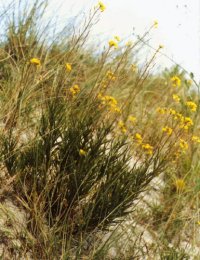 tion lights, on Côtil du Val, at Crabby Bay, on the commons, cliff paths, etc. A whole range of yellow flowered plants, Ragwort, Hawkweeds, Hawkbits, Hawk's-beards, Pineapple- weed (Matricaria discoidea), Common Fleabane (Pulicaria dysenterica), Dandelions of many types, Perennial, Smooth & Prickly Sow-thistles (Sonchus arvensis, S. oleraceus & S. asper), Bristly, Hawkweed and Druce's Oxtongues (Picris echioides, P. hieracoides & P. hieracoides var. incana, photo on left), Cat's-ear and Smooth Cat's-ear, Hoary Mustard, Wild and Sea
tion lights, on Côtil du Val, at Crabby Bay, on the commons, cliff paths, etc. A whole range of yellow flowered plants, Ragwort, Hawkweeds, Hawkbits, Hawk's-beards, Pineapple- weed (Matricaria discoidea), Common Fleabane (Pulicaria dysenterica), Dandelions of many types, Perennial, Smooth & Prickly Sow-thistles (Sonchus arvensis, S. oleraceus & S. asper), Bristly, Hawkweed and Druce's Oxtongues (Picris echioides, P. hieracoides & P. hieracoides var. incana, photo on left), Cat's-ear and Smooth Cat's-ear, Hoary Mustard, Wild and Sea
 Radish, Wall Rocket (Diplotaxis tenuifolia, photo on right), several Buttercup species, Large-flowered and Fragrant Evening-primrose (Oenothera glazioviana & O. stricta).
Radish, Wall Rocket (Diplotaxis tenuifolia, photo on right), several Buttercup species, Large-flowered and Fragrant Evening-primrose (Oenothera glazioviana & O. stricta).
The large white trumpets of the Bellbines, (Hedge & Large Bindweed, Calystegia sepium & c. silvatica ) were gracing the hedges and scrub, with the closely related Field Bindweed (Convolvulus arvensis), on most verges, banks and dune areas, varying in colour from almost white, through several pink striped forms, to quite a dark pink with only
narrow bands of white. Sea Bindweed (Calystegia soldanella,
 photo on right), looking like a large fleshy form of Field Bindweed is plentiful on dunes at Longis, Crabby and Platte Saline bays. Sea Kale, frequent above HWM at Platte Saline and Crabby Bays, with a few plants at Longis Bay and Sea Beet, common near the sea all round the island, were both in seed, whilst the several "garden escape" domestic roses out in the wild, white Alberic Barbier and pink Dorothy Perkins at Platte Saline, Dorothy Perkins at Blue Bridge and red American Pillar at Crabby were all in bloom.
photo on right), looking like a large fleshy form of Field Bindweed is plentiful on dunes at Longis, Crabby and Platte Saline bays. Sea Kale, frequent above HWM at Platte Saline and Crabby Bays, with a few plants at Longis Bay and Sea Beet, common near the sea all round the island, were both in seed, whilst the several "garden escape" domestic roses out in the wild, white Alberic Barbier and pink Dorothy Perkins at Platte Saline, Dorothy Perkins at Blue Bridge and red American Pillar at Crabby were all in bloom.
There were a lot of butterflies about today; Common Blue, Wall, Speckled Wood, Small White, Peacock, etc. and Emperor Dragonflies were all seen.
2nd July. The Myrtle (Myrtus ugni photo on right below) was in flower at its only known site, on the east coast and several seedlings were noted within about 2m. The large patch of Chicory (Cichorium intybus), noted last year on recently spread soil just above the low cliff opposite the Clonque cottage has grown considerably. The large number of Common Poppies seen here last year and again now, evidently came from the same packet.
6th July. Several Gatekeeper butterflies came right
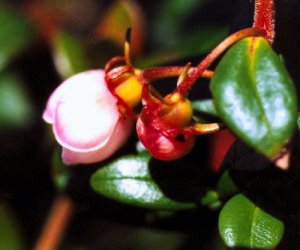 into my conservatory and even into the house, again the first of the season and somewhat further west than any seen in earlier years. First recorded in the island about 6 years ago on the east coast by my wife and I, these have become earlier, more frequent and widespread since. During the later part of the month, several more were noted along the verge up Tourgis Hill about 200m further west still. more Emperor Dragonflies and several pairs of Blue-tailed Damselflies noted in the garden round the ponds with one pair of damselflies apparently mating on a white shirt on the washing line. When disturbed they took off, still coupled.
into my conservatory and even into the house, again the first of the season and somewhat further west than any seen in earlier years. First recorded in the island about 6 years ago on the east coast by my wife and I, these have become earlier, more frequent and widespread since. During the later part of the month, several more were noted along the verge up Tourgis Hill about 200m further west still. more Emperor Dragonflies and several pairs of Blue-tailed Damselflies noted in the garden round the ponds with one pair of damselflies apparently mating on a white shirt on the washing line. When disturbed they took off, still coupled.
7th July. Ragwort is now fully in flower in many places. The field below the Fort Albert glacis right up to the campsite, usually with one of the most extensive infestations, has been mown more than once recently and it is not showing here at the moment. Shunned by cattle and horses grazing the fields when growing, (although eaten by sheep apparently without ill effects), once dried on the ground it is sometimes eaten by them and, if the field is cut for hay before the Ragwort is removed, cattle and calves will later eat the hay, sometimes with fatal results from the alkaloids it contains. At this month's States session, the Mauvaises Herbes (Noxious Weeds) law, in place since 1933, has been amended. Hogweed has been removed, most likely because the worst culprits have long been the States themselves, they can hardly prosecute private landowners or their own tenants for failing to eliminate it. It has spread vastly over the last ten years.
The Indian Chestnut (Aesculus indica) (photo on right) p
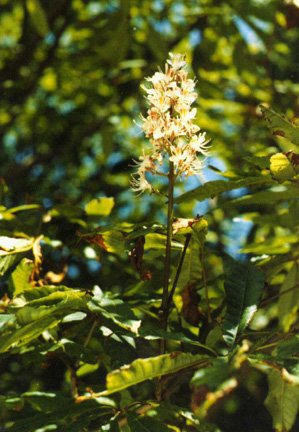 lanted in Connaught Square by the Queen many years ago, has just come into flower (and in fact remained in flower well into August). Lucerne (Medicago sativa) in many shades of pink, blue and purple, from almost white to nearly black, is to be seen flowering in many verges, field margins, etc.
lanted in Connaught Square by the Queen many years ago, has just come into flower (and in fact remained in flower well into August). Lucerne (Medicago sativa) in many shades of pink, blue and purple, from almost white to nearly black, is to be seen flowering in many verges, field margins, etc.
9th July. Small patches of Rose-Bay Willowherb (Chamerion angustifolium), not very common in Alderney, are in flower under the old Cypress trees near Battery Crossing, amongst bracken and gorse along the track to Fort Clonque and in a small corner of a field above the track to St. Vignalis' Garden. Fennel (Foeniculum vulgare) is just coming into flower almost everywhere on the sandy soils. By the end of the month fields and commons will be bright yellow with its flowering heads, above the aniseed-scented, finely dissected foliage, some plants reaching almost 2m in height.
13th July. Centaurea cineraria, a sort of 'Hardhead' (or Knapweed), native of Italy, two plants first noted four or five years ago along the top of a hi
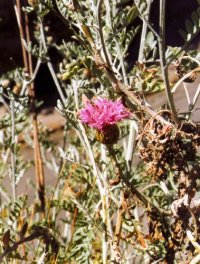 gh wall below the German water tower in Les Mouriaux, has spread here and there are now more than a dozen plants flowering on top of the wall (photo on right).
gh wall below the German water tower in Les Mouriaux, has spread here and there are now more than a dozen plants flowering on top of the wall (photo on right).
17th July. Huge purple patches of Wild Thyme in flower amongst the short turf on Longis common, round Mannez Quarry and several other grassy areas. The several very large shrubs of Everlasting Flower (Helichrysum petiolare photo on left below) on the bank of Hawthorn, Elder and Bramble scrub on Bluestone Hill are now covered in dusty, dark yellow-brown, blooms with many younger plants struggling for survival in the mown road margins. This escaped from the garden below the road level opposite many years ago and some of the bushes are now 5-6m across.
 19th July. The east end of Braye meadow mown for hay. With very little rain on most days this month the crop was dried, baled and removed, all in the dry by 22nd.
19th July. The east end of Braye meadow mown for hay. With very little rain on most days this month the crop was dried, baled and removed, all in the dry by 22nd.
21st July. Greater Knapweed (Centaurea scabiosa photo on right below), the largest and least common of Alderney's Knapweeds is now flowering with a few plants in each of several spots, by the entrance to the Arsenal, at the bottom of Butes Lane, etc. Great Willowherb (Epilobium hirsutum), a very handsome moisture-loving plant usually about 1.5m tall is now giving broad bands of white centred mauve-pink flowers all round Platte Saline pond, in Mannez Quarry, along the Chemin du Meunier, in gutters here and there and in
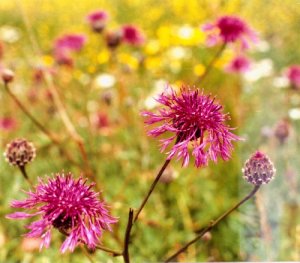 many other damp places. A good crop of Wild Teasels (Dipsacus fullonum photo on left below) is flowering on the verge opposite the junction of this road and La Marette. Teasels have been frequent within about 100m of this spot at opposite ends of the same field, for some years, probably escaped from nearby gardens. A small vegetable patch nearby has a few self sown Globe Artichokes (Cynara scolymus) growing up to 2m tall with many very small (for the species), extremely spiny (and almost certainly inedible) flowering heads.
many other damp places. A good crop of Wild Teasels (Dipsacus fullonum photo on left below) is flowering on the verge opposite the junction of this road and La Marette. Teasels have been frequent within about 100m of this spot at opposite ends of the same field, for some years, probably escaped from nearby gardens. A small vegetable patch nearby has a few self sown Globe Artichokes (Cynara scolymus) growing up to 2m tall with many very small (for the species), extremely spiny (and almost certainly inedible) flowering heads.
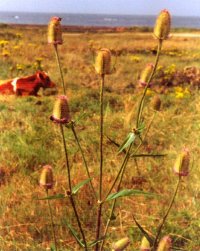 23rd July.
23rd July.
25th July. Bell-heather (Erica cinerea), flowering all round the outside walls of Fort Tourgis, especially along the track to Clonque and in a few spots along the road from the fort to the airport. A surprise in the verge here was a small patch of Eyebright (Euphrasia spp.). Reaching almost the top of the rise towards the airport a field on the seaward side has a small clump of New Zealand Flax (Phormium tenax photo on right below), on top of a small German bunker in the bank between two fields. I first noticed it about 12 years ago and haven't seen it for the last 2-3 years, but it now has a single fl
 owering spike towering nearly 3m into the sky. The hillside down the Zig-Zag was brilliant with its rosy-purple flowers and a small number of Heather (Calluna vulgaris), showing spikes of tiny pale mauve flowers amongst them. The small scattered colony of Slender St. John's-wort (Hypericum pulchrum photo on left below), a delicate 5-petalled yellow flower, on the bank down one of the legs of the Zig-Zag was almost obscured by the surrounding vegetation, which included long lines of yellow-flowered Leafy Hawkweed (Hieracium umbellatum), whilst many small mounds of the delicate 4-petalled, Maltese Cross-shaped flowers of Tormentil
owering spike towering nearly 3m into the sky. The hillside down the Zig-Zag was brilliant with its rosy-purple flowers and a small number of Heather (Calluna vulgaris), showing spikes of tiny pale mauve flowers amongst them. The small scattered colony of Slender St. John's-wort (Hypericum pulchrum photo on left below), a delicate 5-petalled yellow flower, on the bank down one of the legs of the Zig-Zag was almost obscured by the surrounding vegetation, which included long lines of yellow-flowered Leafy Hawkweed (Hieracium umbellatum), whilst many small mounds of the delicate 4-petalled, Maltese Cross-shaped flowers of Tormentil
 (Potentilla erecta), one of the few 4-petalled members of the Rose family, peeped out between the two heathers and along the sides of the track. A few more Glanville Fritillary butterflies were seen along this trackway, one of their more usual haunts and also about half a dozen Gatekeepers.
(Potentilla erecta), one of the few 4-petalled members of the Rose family, peeped out between the two heathers and along the sides of the track. A few more Glanville Fritillary butterflies were seen along this trackway, one of their more usual haunts and also about half a dozen Gatekeepers.
Returning along the track past Blue Bridge, the Hedge Fuchsia (Fuchsia magellanica) just above the Vau Pommier stream was covered in blossom and the Dorothy Perkins Rose mixed up with it was also flowering. A large patch of Common Horsetail (Equisetum arvense), is regularly to be found where a small spring drips water onto the trackway here. In the little quarry along this track Montbretia (Crocosmia x crocosmiflora) was making a brave show of orange, with a smaller patch of Tutsan (Hypericum androsaemum), behind it. The clump of Galingale (Cyperus longus) here, one of only 3 or 4 sites in the island, is just coming into flower. It hasn't spread much in the last ten years. The Marsh Thistles and Ragged Robin which were earlier giving a grand patch of tall, coarse spiny leaves with dark mauve flowers and delicate short waving pinky-white flowers respectively, are now both in seed and drying up. The large patch of Chicory opposite the cottage was still bearing a mass of heavenly blue flowers and was surrounded by a forest of Common and Opium Poppies, Ox-eye Daisies and Scentless Mayweed. Reaching Platte Saline again, Square-stemmed St. John's-wort (Hypericum tetrapterum) was noted near the pond. more Blue-tailed Damselflies here.
27th July. Extensive mowing by the States, including cutting back the lower parts of roadside banks and several grassy areas and commons, and sweeping many of the gutters has made the island look very tidy. In addition, the new farmer has topped extensive areas of farmland after the cattle had grazed it, thus removing many of the noxious weeds and taller wild plants such as Wild and Sea Radish and Fennel. Despite maintaining the closure of considerable lengths of the cliff path as a precaution against introducing the Foot-and Mouth scourge which has been ravishing the UK, which has prevented some mowing of the coastal and inland trackways, the whole island is looking more cared for than for some years.
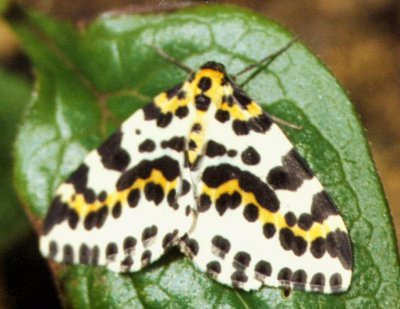 29th July. Hottest day of the year so far, 27º reached. A Magpie Moth (photo on left) in the bedroom and others seen outside. First I've seen this year. The yellow, Buddleja x weyeriana (photo below with parents) in the garden, a cross between the ordinary mauve Buddleia B. davidii and the Orange-ball Tree B. globosa has come into flower and is already attracting its usual quota of butterflies and moths. Red Admirals, Small and Cabbage Whites, Peacocks, etc. Haven't seen any Small Tortoiseshells yet this year, they seem to have got very scarce lately.
29th July. Hottest day of the year so far, 27º reached. A Magpie Moth (photo on left) in the bedroom and others seen outside. First I've seen this year. The yellow, Buddleja x weyeriana (photo below with parents) in the garden, a cross between the ordinary mauve Buddleia B. davidii and the Orange-ball Tree B. globosa has come into flower and is already attracting its usual quota of butterflies and moths. Red Admirals, Small and Cabbage Whites, Peacocks, etc. Haven't seen any Small Tortoiseshells yet this year, they seem to have got very scarce lately.
30th July. An enormous number of Gatekeeper Butterflies noted down the track between Blanchard and Houmet Herbé and all along the east coast. A few Wall, Small Copper and Blue butterflies and a considerable number of Cinnabar Moths were also flying along here. Both the Alderney Sea-lavender and the Broad-leaved Sea-lavender (Limonium normannicum & L. binervosum) were in full bloom near the fort, and a few yards away on the St. Esquere headland, masses of Autumn Squill (Scilla autumnalis) were flowering as well as the Heather and Bell Heather, which were attracting these insects. Nearer Longis Bay what looked like a Cattle Egret, with two Small Egrets were searching the rocks along the tide line.

Buddleja x weyeriana (centre) with parents B. davidii (r) & B. globosa (l)
31st July. Another month gone. Brilliant sunshine from about 5.30am and almost calm conditions of both sea and wind. Occasional cloud drifted across during the later morning and afternoon, but it remained warm and humid.
 tion lights, on Côtil du Val, at Crabby Bay, on the commons, cliff paths, etc. A whole range of yellow flowered plants, Ragwort, Hawkweeds, Hawkbits, Hawk's-beards, Pineapple- weed (Matricaria discoidea), Common Fleabane (Pulicaria dysenterica), Dandelions of many types, Perennial, Smooth & Prickly Sow-thistles (Sonchus arvensis, S. oleraceus & S. asper), Bristly, Hawkweed and Druce's Oxtongues (Picris echioides, P. hieracoides & P. hieracoides var. incana, photo on left), Cat's-ear and Smooth Cat's-ear, Hoary Mustard, Wild and Sea
tion lights, on Côtil du Val, at Crabby Bay, on the commons, cliff paths, etc. A whole range of yellow flowered plants, Ragwort, Hawkweeds, Hawkbits, Hawk's-beards, Pineapple- weed (Matricaria discoidea), Common Fleabane (Pulicaria dysenterica), Dandelions of many types, Perennial, Smooth & Prickly Sow-thistles (Sonchus arvensis, S. oleraceus & S. asper), Bristly, Hawkweed and Druce's Oxtongues (Picris echioides, P. hieracoides & P. hieracoides var. incana, photo on left), Cat's-ear and Smooth Cat's-ear, Hoary Mustard, Wild and Sea
 Radish, Wall Rocket (Diplotaxis tenuifolia, photo on right), several Buttercup species, Large-flowered and Fragrant Evening-primrose (Oenothera glazioviana & O. stricta).
Radish, Wall Rocket (Diplotaxis tenuifolia, photo on right), several Buttercup species, Large-flowered and Fragrant Evening-primrose (Oenothera glazioviana & O. stricta).
 photo on right), looking like a large fleshy form of Field Bindweed is plentiful on dunes at Longis, Crabby and Platte Saline bays. Sea Kale, frequent above HWM at Platte Saline and Crabby Bays, with a few plants at Longis Bay and Sea Beet, common near the sea all round the island, were both in seed, whilst the several "garden escape" domestic roses out in the wild, white Alberic Barbier and pink Dorothy Perkins at Platte Saline, Dorothy Perkins at Blue Bridge and red American Pillar at Crabby were all in bloom.
photo on right), looking like a large fleshy form of Field Bindweed is plentiful on dunes at Longis, Crabby and Platte Saline bays. Sea Kale, frequent above HWM at Platte Saline and Crabby Bays, with a few plants at Longis Bay and Sea Beet, common near the sea all round the island, were both in seed, whilst the several "garden escape" domestic roses out in the wild, white Alberic Barbier and pink Dorothy Perkins at Platte Saline, Dorothy Perkins at Blue Bridge and red American Pillar at Crabby were all in bloom.
 into my conservatory and even into the house, again the first of the season and somewhat further west than any seen in earlier years. First recorded in the island about 6 years ago on the east coast by my wife and I, these have become earlier, more frequent and widespread since. During the later part of the month, several more were noted along the verge up Tourgis Hill about 200m further west still. more Emperor Dragonflies and several pairs of Blue-tailed Damselflies noted in the garden round the ponds with one pair of damselflies apparently mating on a white shirt on the washing line. When disturbed they took off, still coupled.
into my conservatory and even into the house, again the first of the season and somewhat further west than any seen in earlier years. First recorded in the island about 6 years ago on the east coast by my wife and I, these have become earlier, more frequent and widespread since. During the later part of the month, several more were noted along the verge up Tourgis Hill about 200m further west still. more Emperor Dragonflies and several pairs of Blue-tailed Damselflies noted in the garden round the ponds with one pair of damselflies apparently mating on a white shirt on the washing line. When disturbed they took off, still coupled.
 lanted in Connaught Square by the Queen many years ago, has just come into flower (and in fact remained in flower well into August). Lucerne (Medicago sativa) in many shades of pink, blue and purple, from almost white to nearly black, is to be seen flowering in many verges, field margins, etc.
lanted in Connaught Square by the Queen many years ago, has just come into flower (and in fact remained in flower well into August). Lucerne (Medicago sativa) in many shades of pink, blue and purple, from almost white to nearly black, is to be seen flowering in many verges, field margins, etc.
 gh wall below the German water tower in Les Mouriaux, has spread here and there are now more than a dozen plants flowering on top of the wall (photo on right).
gh wall below the German water tower in Les Mouriaux, has spread here and there are now more than a dozen plants flowering on top of the wall (photo on right).
 19th July. The east end of Braye meadow mown for hay. With very little rain on most days this month the crop was dried, baled and removed, all in the dry by 22nd.
19th July. The east end of Braye meadow mown for hay. With very little rain on most days this month the crop was dried, baled and removed, all in the dry by 22nd.
 many other damp places. A good crop of Wild Teasels (Dipsacus fullonum photo on left below) is flowering on the verge opposite the junction of this road and La Marette. Teasels have been frequent within about 100m of this spot at opposite ends of the same field, for some years, probably escaped from nearby gardens. A small vegetable patch nearby has a few self sown Globe Artichokes (Cynara scolymus) growing up to 2m tall with many very small (for the species), extremely spiny (and almost certainly inedible) flowering heads.
many other damp places. A good crop of Wild Teasels (Dipsacus fullonum photo on left below) is flowering on the verge opposite the junction of this road and La Marette. Teasels have been frequent within about 100m of this spot at opposite ends of the same field, for some years, probably escaped from nearby gardens. A small vegetable patch nearby has a few self sown Globe Artichokes (Cynara scolymus) growing up to 2m tall with many very small (for the species), extremely spiny (and almost certainly inedible) flowering heads.
 23rd July.
23rd July.
 owering spike towering nearly 3m into the sky. The hillside down the Zig-Zag was brilliant with its rosy-purple flowers and a small number of Heather (Calluna vulgaris), showing spikes of tiny pale mauve flowers amongst them. The small scattered colony of Slender St. John's-wort (Hypericum pulchrum photo on left below), a delicate 5-petalled yellow flower, on the bank down one of the legs of the Zig-Zag was almost obscured by the surrounding vegetation, which included long lines of yellow-flowered Leafy Hawkweed (Hieracium umbellatum), whilst many small mounds of the delicate 4-petalled, Maltese Cross-shaped flowers of Tormentil
owering spike towering nearly 3m into the sky. The hillside down the Zig-Zag was brilliant with its rosy-purple flowers and a small number of Heather (Calluna vulgaris), showing spikes of tiny pale mauve flowers amongst them. The small scattered colony of Slender St. John's-wort (Hypericum pulchrum photo on left below), a delicate 5-petalled yellow flower, on the bank down one of the legs of the Zig-Zag was almost obscured by the surrounding vegetation, which included long lines of yellow-flowered Leafy Hawkweed (Hieracium umbellatum), whilst many small mounds of the delicate 4-petalled, Maltese Cross-shaped flowers of Tormentil
 (Potentilla erecta), one of the few 4-petalled members of the Rose family, peeped out between the two heathers and along the sides of the track. A few more Glanville Fritillary butterflies were seen along this trackway, one of their more usual haunts and also about half a dozen Gatekeepers.
(Potentilla erecta), one of the few 4-petalled members of the Rose family, peeped out between the two heathers and along the sides of the track. A few more Glanville Fritillary butterflies were seen along this trackway, one of their more usual haunts and also about half a dozen Gatekeepers.
 29th July. Hottest day of the year so far, 27º reached. A Magpie Moth (photo on left) in the bedroom and others seen outside. First I've seen this year. The yellow, Buddleja x weyeriana (photo below with parents) in the garden, a cross between the ordinary mauve Buddleia B. davidii and the Orange-ball Tree B. globosa has come into flower and is already attracting its usual quota of butterflies and moths. Red Admirals, Small and Cabbage Whites, Peacocks, etc. Haven't seen any Small Tortoiseshells yet this year, they seem to have got very scarce lately.
29th July. Hottest day of the year so far, 27º reached. A Magpie Moth (photo on left) in the bedroom and others seen outside. First I've seen this year. The yellow, Buddleja x weyeriana (photo below with parents) in the garden, a cross between the ordinary mauve Buddleia B. davidii and the Orange-ball Tree B. globosa has come into flower and is already attracting its usual quota of butterflies and moths. Red Admirals, Small and Cabbage Whites, Peacocks, etc. Haven't seen any Small Tortoiseshells yet this year, they seem to have got very scarce lately.
